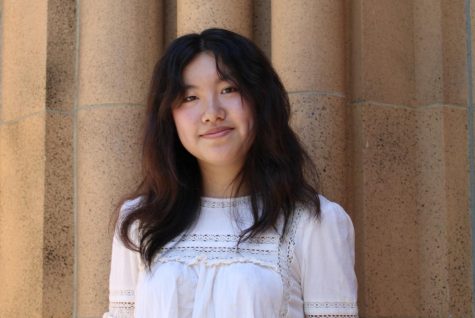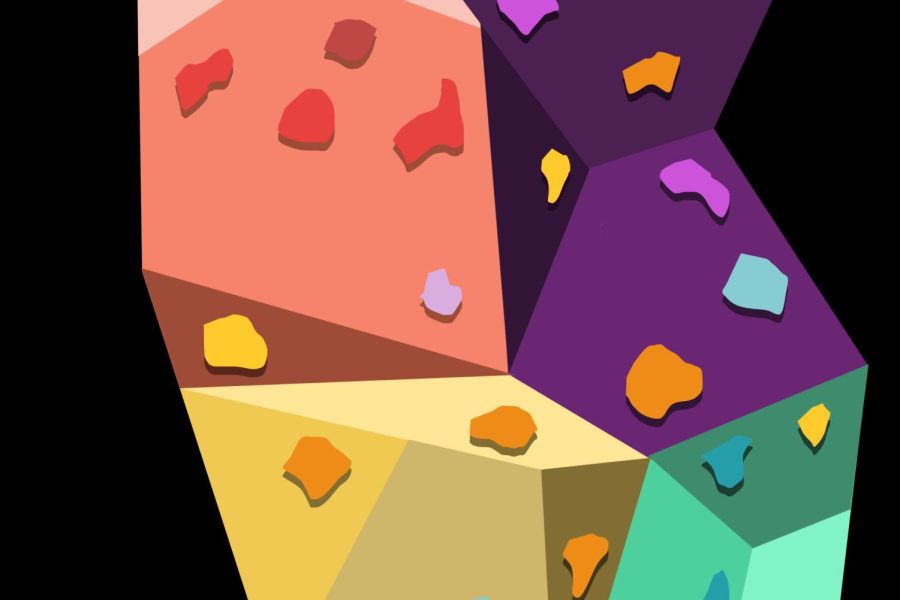Rock On!
More than just scaling a wall, the sport of rock climbing connects the thrill of challenge with the warmth of community
Sweating, Paly senior Maya Quinlan clings to the climbing wall, desperately searching for a rock to hold onto among the many jutting out just beyond her reach. Without a proper handhold, her foot could slip and she could fall from the wall at any time. This is the adventurous world of rock climbing.
Why would anyone willingly subject themselves to such an experience? For one, those who climb note that the community built when climbers come together to share their passion is an excellent motivator for self-improvement.
Former C Mag Editor-in-Chief Emma Joing reflects on the sense of community she has gained through her love of rock climbing.
“I only became a better climber because I was surrounded by other like-minded people who were really passionate about climbing and were really driven to try hard and get better,” Joing said. “They pushed me to be better.”
Support from other climbers is necessary throughout the route a climber must take for each climb. This not only improves the climber’s stamina and effort but also raises the mood of the entire gym.
“It’s much easier to finish a climb when somebody gives you advice on how to do it, so that’s a lot of where the support comes in,” Joing said.
This environment pushes climbers to better themselves by using critical thinking and strength while laying the groundwork for a stronger community.
Paly junior and rock climbing enthusiast Anne Threlkeld has witnessed firsthand the importance of seeking help and feedback from people trying to solve similar puzzles at the gym. She mentions beta, which is a term that explains the “correct” route for completing a climb.
“People are super open to asking questions and learning from each other and a lot of people will share beta, which is how you would solve a problem,” Threlkeld said.
Solving the route logically is an extremely strenuous aspect of climbing, as the routes vary in difficulty depending on each individual climber’s skill level. This is where help and support from other climbers come in.
This encouragement from teammates and acquaintances isn’t necessarily a cornerstone of sports in general. The culture surrounding some sports foster a sense of competition that alienates athletes from one another.
“I’ve noticed that when [I’ve done] other sports, it kind of felt like it was getting more intense and more toxic at a younger age,” Joing said. “It was like you had to be really good at the sport.”
The community at Planet Granite and other climbing gyms combat the idea of sports as a competitive environment through a culture of kindness.
Quinlan has experienced this kindness during her climbing sessions at Planet Granite. She illustrates her experience as a new climber when she started at the beginning of her junior year in high school.
“I really enjoy the community and how friendly everyone is,” Quinlan said. “The way you look doesn’t really define how good you are at climbing or what your level is.”
Joing had an encouraging experience when she started climbing as well, which has led to her positive outlook on the sport even if you are a nervous beginner.
“If you’re going to go to the gym and you’re kind of scared that people are going to be judging you because you’ve never done this before, don’t be scared about that at all,” Joing said. “If you’re not super good, nobody’s going to look down on you. They’re going to cheer you on.”
There is no judgment or pressure from others, only encouragement from fellow climbers to help complete a successful climb. Furthermore, the people that build up this environment create a better place for anyone regardless of any level or strength, which creates a unique and passionate community.
For senior Evie Kramer, climbing has never been a solo effort.
“It’s all about the people, honestly, especially as I’ve gotten older,” Kramer said. “From the start, it’s always been about climbing with my family and my friends and the people that I love. Really, climbing is the side piece to the connection [that] I get from it.”
It’s undeniable that being part of the climbing community fosters unique bonds built on support and encouragement, but even a community as close-knit as this one features never-ending debates on issues like the importance of strength versus critical thinking.
Although strength won’t determine the amount of climbers’ encouragement, some think it helps climbers complete a climb. Paly senior Reed Shulman appreciates the physical element involved in climbing.
“You’re either strong enough to do something or you’re not,” Shulman said. “Once you reach a certain level of strength, you have the guarantee of being able to do something, whereas if you’re not as strong, [it isn’t possible].”
Similarly to Reed, Quinlan highlights the relevance of strength when climbing, and how strength can help you improve quicker than others, but if you lack it, people will still continue to support others and their endeavors. However, she also calls attention to the benefits of a positive mentality vs. a negative mentality.
“Especially in this sport, I think that strength matters,” Quinlan said. “The people who are really good are usually pretty buff, especially when it comes to bouldering. It takes a lot of strength to get up harder graded climbs.”
Although she mentions the significance of physical strength and stamina, she also highlights the importance of having the right mentality when it comes to completing a challenging climb.
“I think that the way you’re feeling during that day mentally is also pretty important,” Quinlan said. “Some days, I’ll show up, and I cannot climb at all, whereas on other days I can complete many climbs.”
Others also believe that on the climbing wall, factors in addition to strength play a significant role. Anyone can climb with the right mentality, strength does not define whether you can climb significantly better than others.
“A lot of times, people think they can just hop on the wall and muscle their way through a climb,” Joing said.
When rock climbing, a person’s critical thinking, and physical strength intertwine to create not only successful climbs but also the most effective environment possible. A person’s strength is important up to a certain point, after which the ability to think on your feet becomes crucial.
“Once you get to a higher level, especially in professional rock climbing, there’s a lot of [problem] solving in different ways,” Threlkeld said.
Striking a balance between physical strength and analytical thinking is key.
“You’re not going to get better if you’re just using your brute strength to try to do a climb,” Joing said. “There’s a lot more skill, a lot more thinking and mental capacity that goes into learning how to tap into that and use it to your advantage on the wall.”
Finding the right way up a route, or problem-solving through different holds is arguably the most predominant principle of climbing. Because of this, anyone can rock climb, even those who do not possess much innate physical strength.
“You can be a way better climber than someone who’s just super strong,” Joing said. “ I know people who are super weak but understand their body, understand these techniques and understand the mental game that goes into climbing.”
What works for one person may not work for another, so there is never a single ‘correct’ way to finish a climb. The way someone completes a climb can be different from how someone else is able to achieve beta.
“There’s a lot of diversity in body types,” Threlkeld said. “There’s a lot of variety in how different people solve problems; people who are taller would do something completely different than someone [who’s] five-foot-one.”
How people choose to solve their climbing puzzles will contrast depending on the individual, due to height, strength, and stamina.
These challenges can come in a variety of levels, made by climbers who grade the system by doing the route over and over again. Once the climbs have been completed and placed on the wall, they will have a sticker that describes the level of the climb.
Paly senior Anna Wingard describes her take on strategizing in climbing and how it has helped her grow stronger and become a better climber overall.
“When I first started, I had no strength at all,” Wingard said. “I was never an upper body strength type of person. I always played lower-body sports. What got me going was thinking about the climb, looking at it, and being able to strategize to see where to go next.”
Wingard was able to assess her climbs with an intense evaluation of the rocks, where they lead, and where to place her hands in order to achieve beta. However, not all of the strategies that climbers use are going to work, meaning their initial thought process may have to be tweaked to obtain a successful outcome.
“Sometimes I would do one thing, and I failed. I would then try something else, and get it. I’ve also gained strength and I think that’s why I’ve been able to excel,” Wingard said. “Critical thinking is really important, especially at the beginning.”
Improvement can come in many different forms, and the opportunities to progress and accomplishments are endless.
The amount of strength or experience that someone has does not hinder their ability to rock climb successfully. That is what students believe make this sport so special.
Rock climbing can bring climbers self-confidence and a sense of accomplishment after completing a climb successfully. It connects individuals to a community of people who share the same love for the sport and similar desires to improve their skills.
Even though there’s always a chance that their hands may slip from the climbing wall, the sport of rock climbing holds the ability to bring people a sense of peace and security.
“I enjoy it so much that I look forward to going in the gym every day,” Joing said. “I look forward to climbing if I’ve had a really hard day at school, I just go in the gym and I climb; I don’t have to worry about anything.”
Art by Kellyn Scheel
Print Issue
Please click on the three vertical dots on the top right-hand corner, then select “Two page view.”

2021-2022 - Staff Writer
2022-2023 - Managing Editor
I joined C Mag because I love that journalism helps shine a light on issues that need addressing...







